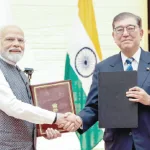Sheikh Hasina’s two-day visit to India from the 21st to the 22nd of June witnessed the leaders of both countries jointly articulating a shared vision for the region. One of the key agreements signed during this visit enabled India and Bangladesh to use each other’s rail lines, reducing both time and costs to trade with Bhutan. India’s push for connectivity in the region throughout the last decade, combined with Bangladesh and Bhutan’s economic compulsions and difficulties, has contributed to a flurry of bilateral agreements and initiatives between the three nations, which are fuelling Bhutan’s aspirations of connectivity and economic growth. Bangladesh and Bhutan have enjoyed good relations due to their geographical proximity, cultural interactions, and close ties between their leadership. In fact, Bhutan was the first country to recognise Bangladesh in 1971. Both countries also signed a transit agreement in 1980 that helped Bhutan export fruits and vegetables, dolomite, limestones, boulders, and processed food. Nonetheless, their trade relations have never met their full potential. While both countries had often discussed connectivity and expansion of ties in the past, they had failed to act on it. However, in recent years, there is a renewed energy in the implementation of these connectivity initiatives, mainly for two reasons: One, India’s push for connectivity in the region has motivated Bhutan and Bangladesh to tap into the momentum. India, keen to fuel its economic growth and deter the ever-increasing Chinese threat in the neighbourhood, has prioritised connectivity over the last decade, and has also accommodated the economic and development needs of its neighbours. For countries like Bhutan and Bangladesh that do not share a border and are separated by India, this push has incentivised them to connect better with each other and overcome their initial hurdles. For instance, in 2014, Bhutan and Bangladesh signed an agreement that permitted trucks from both countries to enter each other’s designated entry and exit points (via India). However, Bangladeshi trucks could not enter India for trade until 2016. And it was only in 2022 that India offered (but not yet implemented) Bangladesh free transit to trade with Nepal and Bhutan. Similarly, in 2019, on par with the 2017 MoU on inland waters between Bangladesh and Bhutan, India, for the first time, helped Bhutan export to Bangladesh through its waterways. A keenness to tap into this momentum of connectivity combined with external shocks like COVID-19 and the Russia-Ukraine war has led to new economic efforts between Bhutan and Bangladesh. On its part, Bangladesh faced severe energy shortages that halted the country’s production and activities, increased imports, and rapidly deteriorated its foreign reserves. On the other hand, strict lockdowns in Bhutan impacted its tourism and commercial activities, which are yet to reach the pre-pandemic levels. High inflation, mass migration of the working population, youth unemployment, and an average economic growth of 1.7 percent in the last five years have further stressed Bhutan’s economy. Bhutan is thus keen on increasing its production and export base through connectivity. It is also developing a 1,000 sq km special administrative region (SAR) in Gelephu near Assam, and a Special Economic Zone (SEZ) in Bangladesh to reverse its economic fate;thus, compelling both Bhutan and Bangladesh to explore new markets, trade opportunities, and diversify supply chains. The latest developments and agreements demonstrate the desire to strengthen Bhutan-Bangladesh relations. On bilateral trade, the PTA could increase trade and economic activities between both countries. This PTA, unlike other South Asian FTAs, covers goods that make up most of the trade. For Bhutan, which has maintained a favourable trade balance with Bangladesh, especially by exporting boulders, dolomites, and limestones, such expansion of trade will add to its foreign reserves. On the other hand, the PTA allows Bangladesh to minimise the deficit and increase its exports. Media reports estimate that Bangladesh’s exports increased to US $9.5 million post-PTA implementation. Subsequent transit agreements between Bangladesh and India will likely fuel this relationship further as it would help Bangladesh trucks to directly go to Bhutan for trade rather than being trans-shipped at Indian borders. There have also been significant attempts to boost regional connectivity. The MoU signed between India and Bangladesh in June 2024 permits both countries to use each other’s railroads without transshipment. Concerning Bhutan , Bangladesh will permit Indian Railways to enter its territories from Gede in India to Darsana in Bangladesh and exit through Chilhati in Bangladesh. On the other hand, India has permitted Bangladesh to enter its territories from Haldibari, India, via Chilhati. Goods from both countries will be unloaded at Hasimara, the closest railway station to the Jaigaon-Phuentsholing region and one of the busiest trade routes between India and Bhutan. With this initiative, Bangladeshi trains can trade up to the borders of Bhutan without any transshipment process, and Indian goods can reach Bhutan via Bangladesh with less time and cost. Besides, India is also developing two rail lines with Bhutan : Banarhat in India to Samtse in Bhutan and Kokrajhar in India to Gelephu in Bhutan. While the former rail route is closer to Hasimara, Bangladesh is permitted to use the Kokrajhar-Gelephu route when the project is complete, thereby allowing Bangladeshi trains to enter Bhutan’s SAR. These rail routes could promote more trade and engagements and help Bhutan avoid the Suvidha taxes levied by the West Bengal government.
Regional Connectivity

Sign Up For Daily Newsletter
Be keep up! Get the latest breaking news delivered straight to your inbox.
By signing up, you agree to our Terms of Use and acknowledge the data practices in our Privacy Policy. You may unsubscribe at any time.
Leave a Comment Leave a Comment
Stay Connected
Latest News
Recent Posts
- Japan to invest 10 trillion yen in India over next one decade
- 50,000 ‘skilled, semi-skilled’ Indian personnel to be sent to Japan: MEA
- HM Shah likely on two-day visit to Jammu from tomorrow
- LG admin forms committee to investigate Shri Mata Vaishno Devi landslide
- All 34 victims identified, bodies handed over to families







